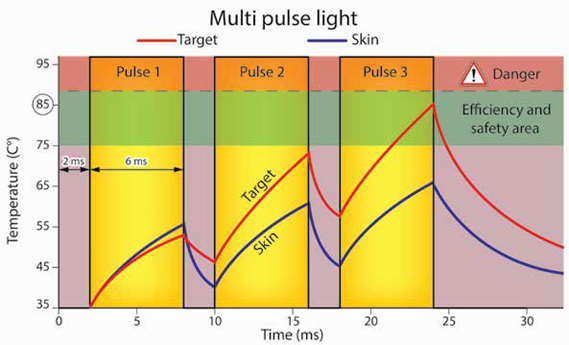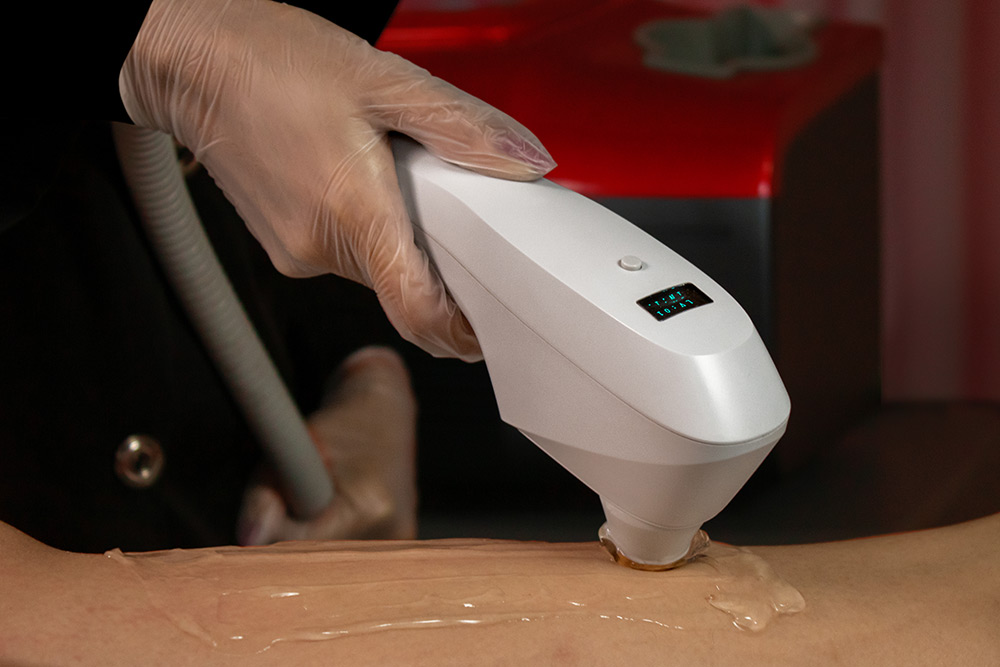Flash: a single pulse or several pulses of powerful light emitted by the machine and released by a specific handpiece.
Pulse of light : energy of the pulseis expressed in Joules and calculated by dividing the Power released in Watts by the duration in milliseconds (ms) of the pulse. The larger the target is the longer the pulse will be. The smaller it is, the shorted it will be. (Long hair= long pulse, short hair= short pulse).
Joules: light energy that can be released by an IPL or laser machine.
Joules/ cm2: levei of light energy per square centimeter that can be released by the machine and through the handpiece. lt is also called fluence.
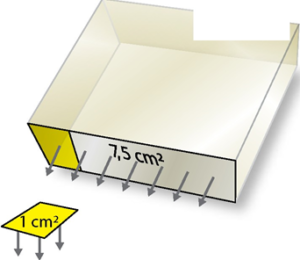
Opticalduct
E = 135 joules = Light Energy emerging from the duct
F= 18 joules/cm2 = Energy Light emerging from a surface of 1 cm2
Absorption filter: ultra-resistant type of filters used by EFB Beauté® that perfectly filter ali undesirable lights (lnfra-reds, UV etc.).
Dichroic filter: type of filters used in low-quality IPL that offer a less efficient filtering (UV, IR) and increases risk of burns. The filter is also very fragile and worns out rapidly.
Monopulse flash: one powerful and short pulse (ideal for phototypes 1 to 3.). Its duration in ms, is defined in proportion to the size of its target (large hair = long pul- se; thin hairs = short pulse). One flash is shot every 3 to 1 second.

Multipulse: series of short pulses to achieve a longer flash duration but yet an ef- ficient one. This mode is specifically dedicated to phototype IV,V and VI. One flash is shot every 3 to 1 second.

Rafale: Series of short flashes made of one single pulse. Three flashes are shot every second.
Monochromatic: light which is emitted on one particular wavelength and has a single colour.

Polychromatic: spectrum of light emitted which consists of a range of colors.
Chromophore: for each treatment, the light has a target, in hair removal, the target (chromophore) is melanin. With skin rejuvenation treatments the target is blood for example. These chromophores can only be reached in certain wavelengths. For example, melanin can only be targeted between 600 nm to 1200 nm.
What do we when doing hair removal?
The functioning principal is to use red light to heat up the papilla (bulb) of the hair up to 75°C to disconnect it from the nerve. Once it is disconnected, it can no longer grow again. Laser and IPL use the same principle of thermal action.

What the difference between laser and IPL?
To destroy hairs, lasers and IPL must operate within the spectrum of absorption of the melanin located between 600 nm and 1200 nm.
Melanin has a wide spectrum of absorption which our IPL cover from 600 to 1100 nm. Laser only operates on one single wavelength.
Relative absorption
What is the difference between laser and IPL?
Because the window of work for hair removal is between 600 nm and 1200 nm, the implication is that both devices work around the spectrum of emission of red light. Indeed, it is only in this window that melanin can be reached SAFELY. Before
600 nm the relative absorption is high but the risk of burn is also extremely high.

To achieve a red color, laser and IPL use different methods.
Laser machines will filter the spectrum of light to only retain a red-only color on a single wavelength. The beam of light will be focused and red only.
On the other hand, with IPL, a spectrum of light is emitted and filtered between
600 nm and 1200 nm to achieve a colour that is a variation of different reds.
Question: is a pure red light VS variation of reds more efficient?
When doing hair removal or skin rejuvenation treatments, what matters is to be working within the appropriate wavelength in complete safety. For hair removal, it is between 600 and 1100. If a driver is looking to reach the highway, whether it is on a motorbike or car does not make a difference.
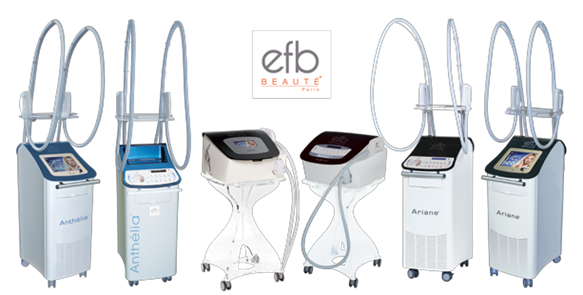
What makes a device effective?
- The fluence
- The shape of the pulse
- The power (kW) & duration (ms) of the pulse delivered
Why is the fluence important?
The fluence is the energy released per square centimeters.
On IPL EFB beauté®, the optical duct has a surface of 7.5 cm² and an energy of
18 J/cm².
Consequently, the energy delivered through the handpiece is 135 J.
For lasers, fluences vary much depending on the type of lasers, as an example, Diode laser have a strong fluence but the power is close to 300 W (VS 900 W with IPL) and the pulse is very long. The implication is hence that it is efficient on thick hairs but not on thin hair which require more power.
Always watch out for the fluence data, if it’s not advertised, it is usually suspicious.
Careful: a high fluence does not guarantee the efficiency of a treatment.
Why? Besause it does not give you information on the characteristics of the pulse.
The role of the shape, power and duration of the pulse
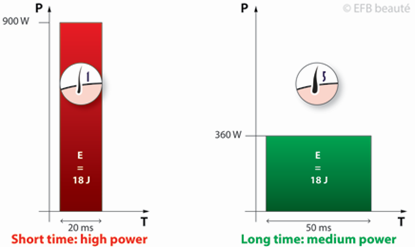
Imagine a very thin hair on which we released one flash with a fluence of 50 J/cm² and another one with 20 J/cm². Can you guess which one will be the most effective? With this information only, it is difficult. Not all pulses are the same and not all pulses will work on all hairs.
Typically, thin hairs require shorts and powerful pulses while thick ones need a medium power and longer pulse.
It is precisely the manufacturer’s ability to eliminate thin hairs that makes a diffe- rence. The reason is that technically speaking, achieving this type of pulses is very difficult. To do so, the device should:
- deliver pulses of a constant level of energy
- deliver square pulses (against “sinusoidal” pulses)
- release powerful and short pulses
- offer a resistant filter on the optical duct capable to resist to the level of energy sent,
- be equipped with an efficient water-cooling system to offer a safe and fast treatment.
Without surprise, many manufacturers are technically neither capable of delivering these types of pulses nor providing the required quality of raw materials.
At EFB beauté® we offer:
- Absorption filters which are ultra-resistant and offer a perfectly safe and efficient filtering,
- Water cooling system both in the machine and the optical guide for a maximum safety,
- Square pulses,
- A constant level of energy from the first to the last flash.
How do I recognisea good IPL/Lases?
One particular criteria will give you the answer to this question: the effectiveness on thin hairs.
Indeed, to destroy thin hairs, it is necessary to release a very powerful and short pulse without burning the client while providing an excellent filtering.
What else do we offer?
A complete mastery on light.
We know how to manipulate light to achieve amazing results on all skin types and hairs.
This is why we offer the multipulse technology for phototype IV, V and VI and the
Rafale technology to perform hair removal treatments 72 hours after sun exposure.
What is IPL, variable pulsed ligth?
Variable Pulsed Light is the equivalent of EFB’s multipulse. It is a series of extremely short square pulses of medium to low power adapted to darker skin to avoid burns and on lighter skins for a less painful treatment (but not efficient on very thin hairs).
For phototypes 1 to 3, the flashes of IPL EFB beauté® are issued in a single pulse
for greater efficiency.
To protect dark skin, the flash of light is composed of a sequence of several identical pulses, spaced by a sufficient time to allow the skin to cool.
The hair accumulates the heat throughout the flash until it reaches the desired tissue denaturation temperature.
The multi-pulse avoids the risk of burns on skin phototype 4-6.
